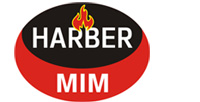MIM’s two most popular injection feeding materials are iron and stainless steel. Along with the increasing demand of stainless steel parts recent years, the researching gets more and more. Now, we will see the three factors that influence the fluidity of stainless steel feeding.
1, the powder loadage, which is a ratio, means the percentage of powder volume from the whole volume. When powder volume gets bigger, the viscosity of feeding material gets higher, so the fluidity is bad. When powder volume gets small, the feeding material viscosity gets low, and the fluidity is good.
2, the shear rate. In the process of injection, stainless steel feeding flows under high shear rate, and the high speed shearing heats the feeding material, so that the viscosity gets low and the fluidity gets strong. Conversely, when the shear rate is low, the speed gets slow and the heat quantity to feeding material is small, so the viscosity will not be low and the fluidity weak.
3, temperature. It means the temperature during injection process and inside of the tool. Temperature is a heating activation process for stainless steel feeding. It will influence the viscosity of the material so to the fluidity. When temperature is high, the viscosity becomes low, and the fluidity gets strong. When temperature is low, the viscosity becomes high and the fluidity gets weak.













